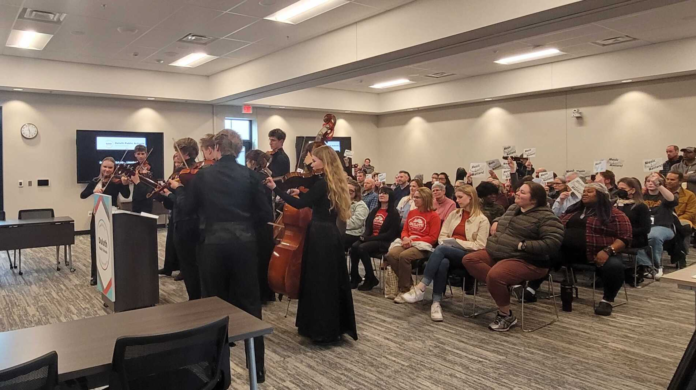Sponsored By
ADVERTISEMENT
ADVERTISEMENT
ADVERTISEMENT
DULUTH — Administrators and Duluth School Board members received an impromptu performance Tuesday from high school orchestra students concerned over proposed changes to the district’s music programs.
During the board’s monthly listening session, where the public has an opportunity to voice concerns, one topic dominated the evening. Multiple speakers voiced frustration and worry over the district’s decision to move away from the longstanding “co-teaching” model in middle school band and orchestra classrooms.
ADVERTISEMENT
Sterling Strings, the elite orchestra group from Duluth East High School, used its allotted three minutes to perform, ending their jaunty rendition of “Frost on the Plow” to applause from the filled room.
“That is the product of the co-teaching model,” said Melanie Sever, a local musician and music educator who spoke after the students’ performance.
“The co-teaching model … has been a cornerstone of instrumental music at ISD 709 middle schools for more than a generation,“ she said. „It’s been widely supported by parents, school board members, students and the community.”
The co-teaching model used at Ordean East and Lincoln Park middle schools requires two teachers collaborating in one classroom. For band and orchestra classes, this might look like one teacher working on foundational skills with individual or small groups of students, while the second teacher conducts the rest of the class. Other times, the teachers might split the class into two groups to work on learning new music and techniques.
But with the district facing a $7.6 million budget reduction, the co-teaching positions are to be eliminated in favor of a “pull-out” model of teaching. Under this method, a single teacher or specialist would work with individual or small groups of students who would be “pulled out” of their regular classrooms for music lessons.
“We recognize that no matter what is reduced, it will have negative impacts, negative impacts on our students, negative impacts on our staff, negative impacts on our families,” said Superintendent John Magas. “None of the reductions are things that we want to do.”
Kevin Hoeschen, a now-retired orchestra teacher, has worked in classrooms with co-teaching and pull-out models. During his years teaching in Wisconsin schools, the pull-out model was the norm. He was able to work with students individually on a two-week cycle, often using his prep hours or staying after school to ensure students received lessons.
ADVERTISEMENT
It wasn’t until he started teaching at Ordean East Middle School that Hoeschen experienced the co-teaching model.
“It’s so much better,” he said. “Really, it works so well and it was so nice to work with other professionals and to have them there to help teach and work with students. … I know I liked it better, and I do think it’s better for students.”
During the listening session, Hoeschen told the board there was a “drastic reduction” in time spent one-on-one or in small groups, without a secondary teacher. That time, dedicated to students developing foundational music skills, becomes less consistent using the pull-out model.
“I made it work (in Wisconsin), and other teachers worked with me to make that happen. A lot of them would allow for students to miss part of a class,” Hoeschen told the News Tribune. “Some didn’t, and I understand and appreciate where they’re coming from. That’s a hard ask — taking a student out of another classroom.”
Several parents and students spoke during the listening session about their experiences with the district’s music programs. Several shared personal anecdotes about the benefits of participating in these programs, socially, academically, and of course, musically.
“We really wanted to show the school board what music really means to the community and to our schools and what it can do,” said Beatrice Javaharian, who performed with Sterling Strings. “So many of us, the people in Sterling (Strings), we would not be as good as we are, as comfortable as we are, excited about playing music as we are, without those middle school teachers.”
Javaharian, a senior at East High School, has been involved in music since she was in the first grade. She’s participated in orchestra and band. Playing the violin with Sterling Strings and the larger Greyhounds Orchestra, Javaharian has traveled to competitions where East historically receives high marks. She’s played a range of venues and events, including performing at the mayor’s State of the City address, and overall, honed her skills as a musician.
ADVERTISEMENT
Not everyone has the same access to music, though, Javaharian said. She worries the proposed changes to the school music programs will only create more disparities in music education for students who don’t have access to private lessons or extracurricular music groups.
“I think that everyone needs to be given the same opportunities to pursue music,” said Javaharian. “It’s not fair to people if you only get to be the best and participate at this level because you have a little more money than someone who maybe can’t afford lessons.”
With displacement notices already sent out to impacted staff members, additional changes to the budget plan and staffing for next year present a challenge, Magas said during the meeting. Adding positions back, at this point, would likely require dipping into the district’s assigned fund balance for next year, potentially missing the target for budget reductions.
He noted the district is pursuing community partnerships and potential grants to help sustain the music programs with external support.
“We realize that is not as good,” Magas told board members. “It’s hard to talk about reductions in services for children as being good options. It’s really about what is the least worst option we can bring forward given our financial realities.”
ADVERTISEMENT
ADVERTISEMENT
